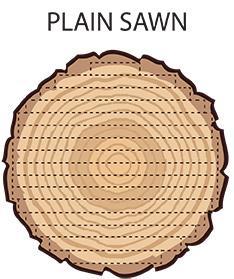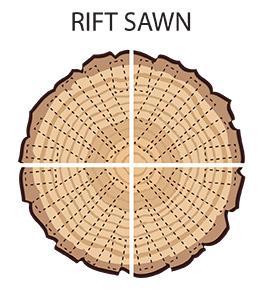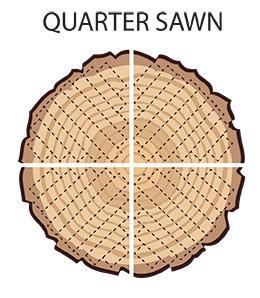When lumber is cut from logs, it is typically cut in one of three ways: quarter sawn, rift sawn or plain sawn. Each type of lumber is dependent on how the log is oriented and cut at the sawmill. The result is a particular orientation of the growth rings on the end grain of the board and is what defines the type of lumber. The type of cut also determines the figure in a piece of wood and the wood’s mechanical properties.
Sound too confusing? This graphic will help…



PLAIN SAWN / FLAT SAWN
Most common, least expensive
Plain sawn, also commonly called flat sawn, is the most common lumber you will find. This is the most inexpensive way to manufacture logs into lumber. Plain sawn lumber is the most common type of cut. The annular rings are generally 30 degrees or less to the face of the board; this is often referred to as tangential grain. The resulting wood displays a cathedral pattern on the face of the board.
QUARTER SAWN
More expensive than plain sawn material
Quarter sawn wood has an amazing straight grain pattern that lends itself to design. Quarter sawn lumber is defined as wood where the annular growth rings intersect the face of the board at a 60 to 90 degree angle. When cutting this lumber at the sawmill, each log is sawed at a radial angle into four quarters, hence the name. Dramatic flecking is also present in red oak and white oak.
RIFT SAWN
Most expensive, least common
Rift sawn wood can be manufactured either as a compliment to quarter sawn lumber or logs can be cut specifically as rift sawn. In rift sawn lumber the annual rings are typically between 30-60 degrees, with 45 degrees being optimum. Manufactured by milling perpendicular to the log’s growth rings producing a linear grain pattern with no flecking. This method produces the most waste, increasing the cost of this lumber. Rift sawn lumber is very dimensionally stable and has a unique linear appearance.